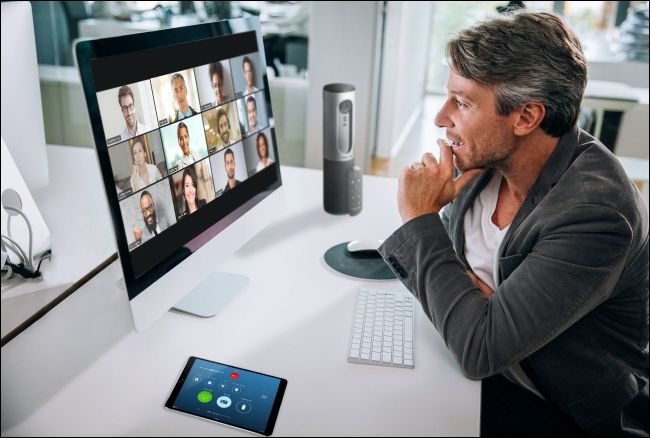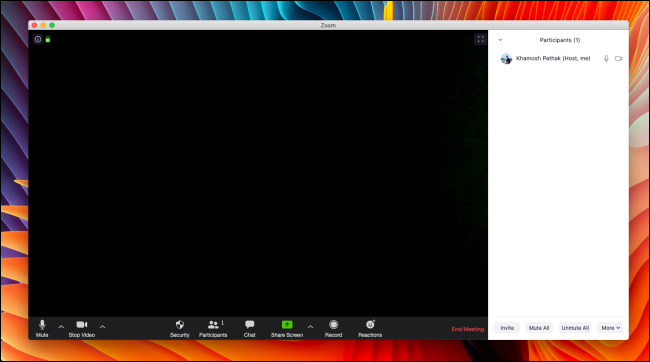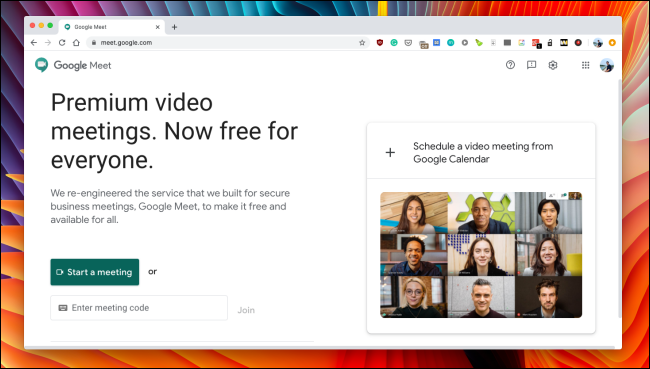Quick Links
Google Meet and Zoom might seem almost the same. While both services make large-scale video conferencing easy, though, there's a lot more going on under the hood. Here's what you need to know to choose the right one for you.
Google Meet Is Best for Small, Quick Meetings
Both Google Meet and Zoom allow you to make large-scale video calls with up to 100 participants for free (for a limited period of time). That's about all they have in common, though.
In April, Google introduced its enterprise-grade G Suite video-conferencing service, Google Meet, to the general public. Anyone with a Google account can create or join a Google Meet call. Up to 100 participants can join a call, and the free plan allows 60-minute meetings (the time limit has been suspended until September 30, however).
While Google Meet lacks most of the advanced features Zoom offers (more on that later), what it does offer is a quick, easy video-calling service right on the web. You don't have to download or install an app to use it.
You just go to the Google Meet website and sign in with your Google account. With one click, you can start a video call (or schedule one with Google Calendar). Share the URL with your participants, and they can join the call after they log in to their Google account.
You can share your screen, change the layout, mute participants, and share text or documents in the chat area.
If you're a G Suite subscriber ($6 per month, per user), you get access to more features, like meeting recordings, live streaming for up to 100,000 viewers, and up to 250 call participants.
That's it, really. There's not much else to say when it comes to Google Meet, and that's not a bad thing.
If you want a simple, private, straightforward way to quickly jump on a meeting with 10 colleagues or 6 friends, use Google Meet. If you want anything more than that, you'll need to go to Zoom territory.
Zoom Is Best for Large Scale Meetings
You know something is popular when it becomes a verb, and Zoom has already passed that milestone. Just as people say "Google it" instead of "search it," they're also saying "Let's Zoom" in reference to online meetings and calls. Then, of course, there's also the whole Zoombombing thing.
There's no question that Zoom has played a big role in both our professional and private lives during the coronavirus pandemic.
In a nutshell, Zoom is an enterprise-grade, large-scale video-calling service with tons of features (not an exaggeration), and it has a free plan. The free plan allows you to call up to 100 participants and use many of the features, but the meeting time is limited to 40 minutes.
Even with the free plan, you can record a call, mute participants, chat, share documents or your screen, make HD video calls, use a whiteboard or virtual backgrounds, send emojis, and a lot more.
Zoom's Pro plan costs $15 per month, per host, but you get an increased meeting time limit of 24 hours and advanced meeting-control features.
Both Google Meet and Zoom work on the web. Anyone with a link can join via a web browser, whether or not they install the app.
When Zoom isn't having a particularly tough day (with a privacy scandal or when it's under heavy load), it's a solid, dependable service that's suitable for large meetings. Plus, for most people, it's safe to use. It can handle 100 participants on an HD call for multiple hours just fine.
The additional benefits of Zoom are its features---lots and lots of them.
If You Want Features, You Want Zoom
If we listed all the features, big and small, that Zoom has and Google Meet doesn't, we'd easily run over Zoom's 40-minute time limit. However, we've listed some of the major ones below:
- Recording: You can record your meetings on your computer. If you have a paid plan, you can record them to the cloud, as well. On Google Meet, only G Suite subscribers can record meetings.
- Virtual backgrounds: From blurred, to still photos and video backgrounds, Zoom has them all. Google Meet has none.
- A waiting room: Here, you see a list of participants who are waiting to join your Zoom call. You can add participants or kick them off a meeting without disconnecting them.
- A whiteboard: This is built-in on Zoom. On Google Meet, you would have to use something like Google Jamboard.
- Gallery View: You can view up to 49 participants on Zoom. Google Meet will only show 16 participants in its Tiled view.
- Interaction: Zoom has Raise Hand and Emoji Response features that Google Meet lacks.
When you look at this list, you can clearly see why Zoom is so popular. It was clearly designed for enterprise-level use and works really well for professional purposes, as well. If you're a team leader or teacher, you would likely use all the features listed above.
This is why you should consider which features are really important to you to choose the right video-calling software. If you need even one of the Zoom-exclusive features, well, your choice has been made.
If You Want Simplicity, Pick Google Meet
Features aren't everything. For some people, Zoom's 40-minute call limit might be too restrictive. Google Meet's 60-minute time limit is much better, as many meetings, classes, or events last about that long.
You might also not want to pay $15 per month for a Zoom Pro account.
If you're looking for a simple service that allows you to quickly hop on a video call with colleagues or friends and maybe share your screen, you'll get by just fine on Google Meet's free plan.
If you don't like either Google Meet or Zoom, there are other options out there you can check out, including Microsoft Teams and Cisco Webex Meetings.





